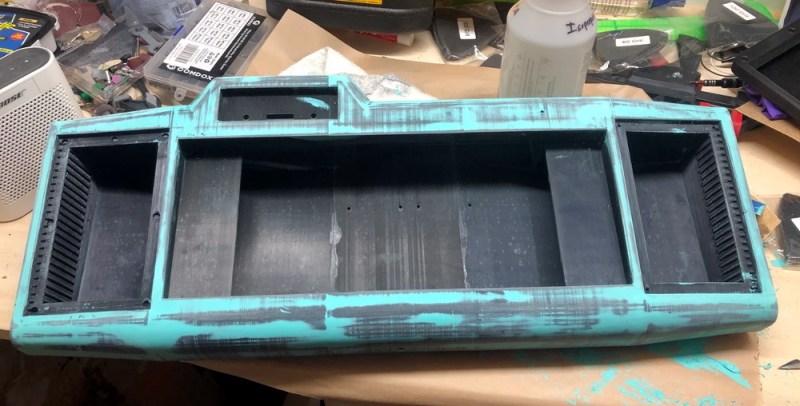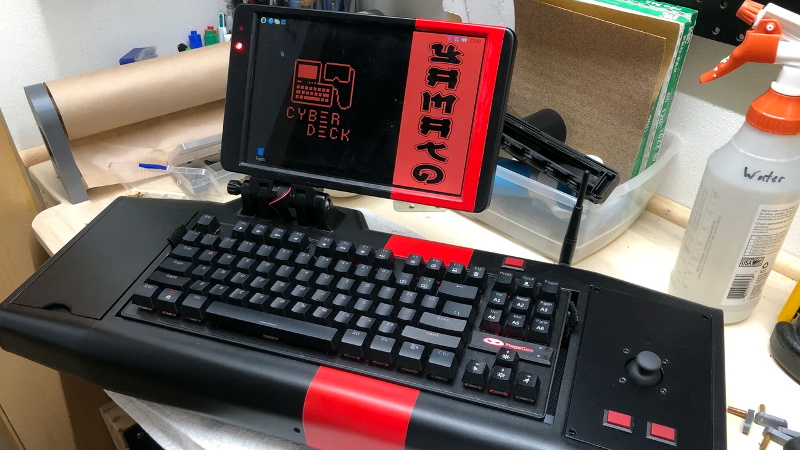Inspired by other builds he’d seen online, [BlastoSupreme] decided to build his very own cyberdeck. There was only one problem: he’d never designed and assembled anything like this before. Wanting to avoid any problems down the line, he reasoned that the safest approach would be to make it so big that he wouldn’t struggle to fit everything inside. Some may say the resulting NX-Yamato, named for the most massive battleship ever constructed, ended up being too large. But that’s only because they are afraid.

In his write-up on The Cyberdeck Cafe, a site dedicated to the community sprouting up around these futuristic personal computers, [BlastoSupreme] describes building this cyberdeck as something of a transformative experience. Looking at the incredible effort that went into this project, we can believe it. From the intricate CAD work to the absolutely phenomenal finish on the Yamato’s 3D printed frame, there’s not a cut corner in sight.
That’s right, nearly every component of this cyberdeck was conjured into existence by squirting out hot plastic. About two kilograms of it, to be precise. It was printed in vertical chunks which were then assembled with adhesive and screws. This modular construction technique allowed [BlastoSupreme] to build what he believes to be the largest cyberdeck ever made. Sounds a lot like a challenge to us.
Admittedly, the massive internal volume of the Yamato is largely unused; all that’s inside it right now is a Raspberry Pi 4 and a X705 power management board that allows the deck to run off of 18650 cells. Of course, all that space could easily be put to use with additional gear or even a larger and more powerful Single Board Computer (SBC) such as the Atomic Pi. There’s even a dedicated compartment in the side for snacks, so no worries there. As [BlastoSupreme] puts it, all that empty space inside is a feature, not a bug.

In the nearly two years that have passed since we first came across one of these Neuromancer inspired builds, we’ve been absolutely blown away by the increasing scale and complexity of these extremely personal computers. Since it seems there’s only a fairly loose idea of what a “proper” cyberdeck should look like in the canonical sense, these builds have been free to fill in the blanks with some pretty outlandish designs. Some of which have earned William Gibson’s personal seal of approval.
















That cyberdeck cafe website is an unusable disaster (on Firefox at least, but even on chrome I’d bet it’s way too busy) but this is a nice build for sure! Just would love to see some of the other projects on that site, sounds right up my alley and I even have a submission or two in mind. But yeah, I can’t do a thing with it.
What problems specifically do you have with the website? If your computers browser and network connection are chocking try from mobile everything is a bit lighter.
Not sure what problem qwert had, for me there was a 45-50s delay while endless page parts are redrawn and loaded, then it went to mostly black with “Something Isn’t Working…
Refresh the page to try again”. Second time through it displays the whole page after 15s, but then as I’m reading it and scroll down it crashes out to the “Something isn’t Working…” message again and all goes black.
The content seems so small compared to the flashy non-content bits. It’s more form than function, in other words.
I got what ajft had too, plus the little skull logo thing would take a second to load before growing to an enormous size, covering most of the page and obscuring links.
Also the animated background and page slide effect are just a bit much imo
Both on mobile and desktop btw
Nothing quite says gritty cyberpunk like using Wix. You’d think one of them would use their cyberdeck for the 15 minutes it would take to setup a Jekyll site.
Wouldn’t Geocities be more appropriate?
Wow… The website *is* and abomination.
It was cool to follow along as it slowly took shape on Instagram. Really nice, and lots to learn from his design choices.
It really looks like a challenging build going through all of those finishing steps. Great job on it
Looks amazing, you could totally fit a full x86 computer in there if you wanted to :D Challenge accepted!
To be fair, the mobile version still has a few issues. Advocate paying users for beta testing (;
This is awesome. Thanks for not making another clock.
Heh, I was hoping we’d be all clocked out after the clock contest but noooooooo…
Question: If it has a 20×4 LCD is it still a cyberdeck?
Cyberdecks in Gibson’s novels were described as back pocket sized to entire top of a desk sized. The important feature was the ability to jack in and interact with cyberspace. Ergo we may infer that connection to internet is a requirement, whatever paradigm is used to interact with it. However, we may also note that the closest analog to a direct neural interface we have now are 3D headsets. IIRC Gibson refers to something similar called “eyephones” for people who haven’t got a jack. Ergo a tiny screen of any description does not really do justice to the Gibsonian concept of a cyberdeck. One may assume however that cyberdecks might have had an accessory screen, for other computing tasks before you fired up the neural or immersive interface, or as an actual monitor for monitoring.
However, for some reason, now the term is applied to 80s aesthetic console keyboards with a crappy offset screen, so if your screen is crappy enough and offset enough, and the rest looks vaguely 80s then yes you can call it a cyberdeck entitling you to membership in the “arguing all day on the internet about what is and what isn’t a cyberdeck” club.
Personally, I think we should hold it to the capability to have an immersive interface. VR or wrap around screens for your whole desk version.
“However, for some reason, now the term is applied to 80s aesthetic console keyboards with a crappy offset screen, so if your screen is crappy enough and offset enough, and the rest looks vaguely 80s then yes you can call it a cyberdeck entitling you to membership in the “arguing all day on the internet about what is and what isn’t a cyberdeck” club.”
LOL perfect. Thank you.
I should also point out though, that due to the pocket size deck and possible conflation with computers described in the later published (But I think earlier in timeline) Bridge Trilogy, that cyberdecks have been associated with wearables, or on the go computing, as opposed to merely portable from one place to another. The form factor now preferred does have a semi-practical root in a possible implementation of an on the go computer, but they most only seem to nod to it, rather than actually implement it. What that would be, would be a computing version of a “keytar”. In that you’d sling it on a shoulder strap cross body and the right end would be low, the left end high, so put the screen on the high end, where it’s easier to read right? Well yeah, that works if you can rotate the screen a bit. Also an argument then for the smaller screen is that you keep it close to your body, and it sits inside your bare minimum personal space, so you’re not giving randoms dead arms with the corners in crowded spaces.
Hang on… I don’t think your screen is crappy enough, or offset enough, for most of that opinion.
Every time I check, small LCD screens for Pi’s are twice the resolution and half the price.
Well.
Most important question, with a name like that.
Does it float?
* 3 waves of Dauntlesses and Helldivers etc *
How about now?
Did Yamato die before the ship was named?